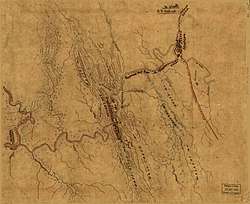New River Railroad
New River mining and railroad company incorporated May 24, 1874 at the Montgomery White Sulfur Springs, WVA. Construction started on September 16 at the New River Depot on the Atlantic, Mississippi and Ohio Railroad.
 New River Railroad Map: Proposed Railroad Route. | |
| Overview | |
|---|---|
| Headquarters | Philadelphia, Pennsylvania |
| Locale | |
| Dates of operation | 1877–1882 (purchased by Norfolk and Western Railroad in 1882) |
| Successor | Norfolk and Western Railroad |
| Technical | |
| Track gauge | 5 ft (1,524 mm) gauge[1] |
| Length | 64 mi (103 km) |
Route
Railroad route was to go north down the New River valley to the Chesapeake and Ohio Railway on the mouth of the Greenbrier River.
History
The company issued 4 million dollars with of stock to pay for the railroad and began finding coal veins all along the route. The company established headquarters at Philadelphia, Pennsylvania.[2] Mining companies could own stock and counties affected could sell bonds or levy taxes to buy stock or to pay off the bonds.[3]
J. Dickenson Sergeant, Thomas Graham, Richard Wood, Henry Beckwith, S. H. Newbery, William Firmstone, R. F. Hoke, P. H. McCaull, P. W. Strother, and Richard B. Roane [3] were the founders of the Railroad. William Firmstone, an industrialist and engineer died three years later, 1877. He had rebuilt Furnace of Glendon Iron Company with intent to modernize it. Frank Firmstone, his son, modernized two more. William Firmstone's son Harry Firmstone, was the first engineer in Virginia to use coke to make pig iron in 1874. The high grade coke, that made this possible, came from the New River.[4] P. H. McCaull was a Delegate in the Virginia House of Delegates and a [5] County Clerk of Roanoke County 1887.[6] P. H. McCaull, was a republican who wrote to William Mahone in 1877 that an election had been lost due to a law that gave democrats control of voting rolls.[7] P. W. Strother was a Delegate.[8] Richard B. Roane, Superintendent, was married to a relative of Sam Houston.[9]
In 1878 Governor of Virginia, Frederick W. M. Holliday, provided as many men as could be spared from the prison, many of them innocent,[10] for Convict leasing to the New River Railroad. The state would subsidize the cost of clothes, food, medical expenses and guards of the men to a maximum of what the state would pay if the men had stayed in prison. In return the railroad would pay back these expenses each year with railroad bonds bearing six percent interest.[3]
The New River Railroad and Mining and Manufacturing Company merged with Bluefield Railroad to form the New River Railroad of West Virginia in December 23, 1881.[11]
These railroads became the basis for Norfolk and Western Railway, New River Division. Norfolk and Western Railway President, Frederick J. Kimball, bought the New River Railroad and transformed the railroad from just transporting agricultural products to making high profits from coal by opening the Pocahontas Coalfield in western Virginia and southern West Virginia.[12]
References
- Congressional Serial Set. U.S. Government Printing Office. 1900. p. 73.
- Annual Reports of Internal Improvement Companies to the Board of Public Works. Board of Public Works. 1874. pp. 187–.
- Virginia (1877,1878). Acts Passed at a General Assembly of the Commonwealth of Virginia. pp. 436–442, 115, 348. Check date values in:
|year=(help) - Mining and Metallurgy. American Institute of Mining and Metallurgical Engineers. 1911. pp. 2–.
- Virginia. General Assembly. House of Delegates (1879). Journal of the House of Delegates of the Commonwealth of Virginia. Superintendent Public Printing. pp. 6–.
- G.S. Jack. History of Roanoke County. Рипол Классик. pp. 27–. ISBN 978-5-87651-384-7.
- Gordon B. McKinney (11 July 2018). Southern Mountain Republicans 1865-1900. University of North Carolina Press. pp. 32–. ISBN 978-1-4696-4413-4.
- Journal of the House of Delegates of the Commonwealth of Virginia. Superintendent Public Printing. 1870. pp. 296–.
- Annual Reports of Internal Improvement Companies to the Board of Public Works. Board of Public Works. 1874. p. 187.
- Litwack, Leon F. Trouble in Mind: Black Southerners in the Age of Jim Crow, (1998) ISBN 0-394-52778-X, p. 271
- Virginia. Railroad Commissioner (1893). Annual Report of the Railroad Commissioner of the State of Virginia. R.F. Walker, superintendent public printing (etc.). p. 460.
- Coal. Scientific Publishing Company. 1882. p. 58.